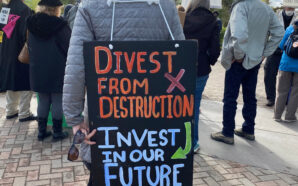Justo Robles, Alejandra Reyes-Velarde & Wendy Fry
CalMatters
On a late September night, Rev. Brad Mills was surprised by the sound of knocking on his parish doors. His small San Diego church didn’t usually receive visitors past mass hours.
Two Venezuelan men at the door said they needed help and were looking for a place to sleep, Mills said.
The church booked them a hotel room for the night and directed them to local shelters and resources, Mills said. But the next night, the men were back. There was no room in any nearby shelters.
And the following night, another four migrants showed up at the church’s door.
Two months later this church, whose leaders ask that it not be named for safety reasons, continues to be one of many San Diego-area nonprofits and faith organizations struggling to provide resources and shelter to tens of thousands of migrants border agents have been releasing onto San Diego streets.
From September through November, U.S. border authorities have dropped off more than 42,000 people on San Diego County streets with no direction or assistance, county officials said.
This is an unusual situation for a region like San Diego, where charities are used to hundreds, but not tens of thousands, of migrant arrivals. Often these asylum seekers are left at bus and trolley stops, instead of being transported to where they can get assistance.
The situation quickly overwhelmed Mills’ church and many other nonprofits, prompting the San Diego County Board of Supervisors in October to spend $3 million for migrant support services. The funds came from what’s left of the $650 million the federal government sent San Diego County for the COVID-19 pandemic.
The county awarded the entire $3 million to a South Bay nonprofit. Its officials said that money will run out by the end of December.
On Tuesday the San Diego County Board of Supervisors will vote on a request for another $3 million in funding for a welcome center that since September has helped many of these migrants reach their final desired destinations.
Nora Vargas, a Democrat who chairs the board of supervisors, said in an emailed statement the proposal to spend more money is a result of Congress’ lack of action, noting that Congress recently rejected President Joe Biden’s supplemental budget request, which would have included $14 billion for immigration and border-related needs.
“As a county, the health and wellbeing of our community continues to be a top priority,” Vargas said.
Supervisor Jim Desmond, a Republican who opposed the initial $3 million allocation, said local resources should not be spent on immigration; it’s the federal government’s responsibility.
“What the federal government should do is allow as many asylum seekers across the border that they can manage,” Desmond said. “What they’re doing is they’re allowing more than they can manage.”
A border city he never heard of
On a recent night, Kevin Mendoza, 23, wandered downtown San Diego, seeking a place to sleep that would be safer than under a bridge. That’s not how he envisioned his life after migrating more than 3,400 miles from Ecuador.
A group of homeless men told him about Mills’ church. Fortunately, Mills had room for him that night and for the next 29 nights.
He left his country because of a spike in crime and violence, including the assassination of a presidential candidate 11 days before the general elections.
Mendoza said the danger for his family intensified when his mother, who sold blankets and bed sheets from a street stand, could no longer afford the extortion fees imposed by local gang members.
Mendoza walked across mountains in the notorious Darién Gap rainforest in Panama and traversed Central American countries to reach Mexico. Nearly a month after leaving his family, he surrendered to immigration officials in El Paso, Texas.
He was fingerprinted and spent his first night inside a Border Patrol cell, colloquially called a hielera, or ice box, due to its cold temperatures. The next day he was handcuffed and ordered to board a plane without being told where it was going, he said.
“De hecho pensaba que ya nos íbamos a nuestro país,” Mendoza said. He thought he was being sent back to his country.
Mendoza was flown to San Diego, a city he had never heard of. He was released outside the airport and then dropped off downtown a few miles away.
The U.S. Customs and Border Protection practice of sending migrants, like Mendoza, from Texas to San Diego is just one part of the problem that has been taxing local shelters. Most of the tens of thousands of migrants who were dropped off came through the Southern California border.
The federal agency did not answer questions about why it is releasing migrants to San Diego streets.
The agency did say it offers assistance to migrants so they can get to their final destination, and that release locations depend on several factors. If a safe location is unavailable due to operational or environmental reasons, or if nonprofits are over capacity, the agency coordinates with local governments to identify alternate safe locations where migrants can access transportation or accommodations.
The Iris Transit Center San Diego, where buses and a trolley meet, is one of three locations where border officers have released thousands of migrants since September, according to several nonprofit leaders. Street releases also occurred in San Ysidro, near the Port of Entry, and in Oceanside, a suburban city north of San Diego.
Insufficient to meet demand
Some of the most vulnerable migrants, including women, children, disabled persons and LGBTQ individuals, were released directly to shelters run by local faith-based organizations, such as Jewish Family Service of San Diego and Catholic Charities Diocese of San Diego.
But asylum seekers not deemed vulnerable were left on city streets, said Kate Clark, senior director of immigration services for Jewish Family Service of San Diego.
The state helps fund several large San Diego County nonprofits whose missions include serving migrants.
The state awarded Jewish Family Service a contract for as much as $44 million through June 2024 to offer migrant settlement services, and Catholic Charities received one for as much as $93.5 million through December 2024.
In September about 100 migrants arrived daily in Oceanside after they were processed by border officials in San Clemente, said Oceanside Mayor Esther Sanchez.
Though local nonprofits are used to dealing with large numbers of migrants arriving to the county, Sanchez said, the past couple of months were “hugely unusual.”
Nonprofit leaders weren’t sure why border officials changed their practices and transported migrants from San Clemente to Oceanside, said Max Disposti, director of the North County LGBTQ Resource Center.
“We were obviously happy to be able to welcome the migrants here because we have a system in place,” Disposti said. “But also we knew it was a system that was not sustainable.”
Disposti said the North County LGBTQ Resource Center spent almost $90,000 helping the newly arrived migrants, including about $3,000 on flights daily to help migrants reach their final destinations and sponsors.
Interfaith Community Services, a nonprofit based in Escondido, spent about $75,000 a week on the migrants, said Logan Goverman, the organization’s marketing strategist.
“We advocated for more, simply because it’s not right that local nonprofits put their resources for something the county and the government should address properly,” said Disposti.
The San Diego Board of supervisors approved $430,529 in October to establish a welcome center in North County, but nonprofit leaders haven’t heard news about where or when. The money comes from the Local Immigrant Integration and Inclusion grant, an initiative by the California Governor’s Office of Business and Economic Development.
“We advocated for more, simply because it’s not right that local nonprofits put their resources for something the county and the government should address properly.”
MAX DISPOSTI, DIRECTOR OF THE NORTH COUNTY LGBTQ RESOURCE CENTER
Scott Murray, spokesperson for California’s Department of Social Services, said the state is funding shelter services with a $150 million investment from the 2023-2024 state budget.
U.S. Congress established its Shelter and Services Program in 2022 to fund non-federal entities that provide shelter to noncitizen migrants released from immigration custody, Murray said. The program also is intended to support federal agencies in the humane release of migrants from short-term holding facilities.
But federal funding “is insufficient to meet the demand,” Murray said.
State Sen. Steve Padilla, a Democrat from Chula Vista, said he applauds the nonprofits and volunteers helping migrants. “They have been heroes in this fight,” he said.
Although the state has made millions of dollars available to support asylum seekers, “we need the federal government to enact a comprehensive solution; one that includes meaningful and lasting immigration reform and provides increased processing capacity, better coordination, and the necessary funding to continue and expand California’s humanitarian response,” Padilla said.
How immigration money is spent
San Diego County chose SBCS, a nonprofit formerly known as South Bay Community Services, to establish a welcome center using the $3 million and to provide services and resources to arriving migrants. SBCS is also using the money to subcontract other organizations to help.
“It got to a point where the need was great, and it was becoming very difficult for the nonprofits that were on it to put enough resources toward it to address everything that needed to be addressed there,” said Mindy Wright, communication director for SBCS.
Before the county approved the initial $3 million, nonprofits helped migrants from the various transit centers’ parking lots. Now migrants are transported from those locations to a welcome center where they are provided food, toiletries and cell phone charging stations for people to connect with loved ones.
The welcome center receives between 400 to 800 migrants daily.
“We have to tell people sometimes ‘You’re in San Diego, California. You have been released from border patrol. You are not under any kind of detention,’” Wright said.
Some nonprofits have raised concerns about how SBCS is spending the money. Specifically some took issue with SBCS spending it on transporting migrants from federal custody to the welcome center, a task formerly handled by border authorities.
“We have questions and would like more information about how these funds have been spent,” said Lindsay Toczylowski, executive director of Immigrant Defenders Law Center, an organization offering legal resources at the welcome center along with SBCS.
Kathryn Lembo, the chief executive officer of SBCS, said Vargas, San Diego Mayor Todd Gloria and state Senator Toni Atkins, a Democrat from San Diego, all asked Homeland Security officials to cover the transportation costs.
Border officials responded that they didn’t have the bandwidth to transport migrants the extra 15 miles to the welcome center, Lembo said.
“Ultimately San Diego, as a border city and as a county with many migrants coming through the area, needs to have an infrastructure to welcome those migrants.”
LINDSAY TOCZYLOWSKI, EXECUTIVE DIRECTOR OF IMMIGRANT DEFENDERS LAW CENTER
SBCS decided to cover the cost of about $6,000 a day, which was less than the daily cost of providing public toilets in the transit center parking lots.
Regarding the criticism from nonprofit leaders, Lembo said, “it’s a shame.”
“They’re not all there every day and they’re not doing the work,” she said. “I’m disappointed and I’m sad, especially for the 60-plus people that every day are doing this work.”
SBCS spent $600,000 on airfare, hotels and shelters. She added that SBCS spent $859,000 hiring local organizations to assist in their response, including Casa Familiar and International Rescue Committee.
“Ultimately San Diego, as a border city and as a county with many migrants coming through the area, needs to have an infrastructure to welcome those migrants,” Toczylowski continued. “And what we would have liked to see is the $3 million being used to help us build that infrastructure in the long term.”
The San Diego Rapid Response Network, one of the primary humanitarian service providers in the region, which includes Jewish Family Service, made recommendations regarding the county contract terms in light of the controversy.
The group said in a statement the county should improve transparency regarding the contract and ensure that it excludes expenses that are already funded and required by the federal government. The group also suggests the county prioritize supporting humanitarian aid efforts at open-air detention sites, “where people seeking asylum continue to be kept in between border fences without any shelter, food, water, or medical care.”
‘Lo haría una y otra vez’ ‘I would do it again’
On a recent morning, Fraidoon Noori was taken by immigration authorities to be processed in San Diego, 75 miles west from the remote desert community of Jacumba, where he and migrants from all over the world were told to stay because indoor holding facilities were overcrowded.
“It’s everybody’s dream to come to America,” said Noori, 24, who was camping outside in Jacumba with other migrants.
Noori said he had volunteered at a nonprofit that advocated for women’s rights in Afghanistan and fled out of fear of being persecuted by the Taliban regime. He went to Pakistan, then to Brazil, then Peru, Ecuador, Central America and Mexico.
Eventually he was transported to the San Diego welcome center. There, Noori said, volunteers helped him find a flight to Seattle. It was also the first time in a while that he was able to wash up, he added.
A day later he was reunited with an uncle whose home will be a momentary shelter as he figures out next steps.
“I feel free now,” Noori said over the phone from Bellingham, Wash. “When I was in Afghanistan I was afraid when I saw the police. I feared they’d arrest me.”
The help hundreds of migrants like Noori received at the welcome center depends on continued funding to keep the San Diego welcome center running.
Meanwhile many migrants brought to San Diego still are searching for a place to stay.
Without proof of income or a credit history, Mendoza can’t rent a place to live. And he doesn’t have a work permit, so he isn’t allowed to legally work in the country. For now, he said, the church has allowed him to stay on a night-by-night basis, as long as there is room.
Despite the harrowing journey and uncertainty, Mendoza said he doesn’t regret migrating to the U.S., a much safer place than his home country.
“Lo haría una y otra vez.” He would make the journey again and again.
CalMatters Assistant Visuals Editor Adriana Heldiz contributed to this report.






